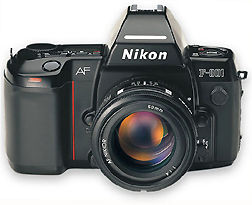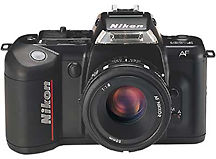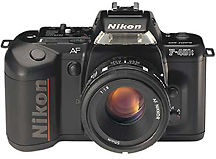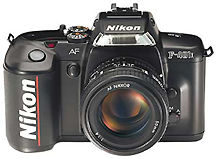
|
To
minimize download time, thumbnails for each model is provided in this core page. |
|
A Pictorial History... |
Nikon F801/N8008, 06.1988
| Message Board |
Questions, issues & Answer(s)
The period between 1984-1987 represented one of the low-tide cycle for Nikon (strictly referring to the segment on photographic products, Nikon is a big corporation with many other investments). The few years of soul searching during this period has fruitfully resulted in a series of successful launching of a few new photographic innovations. The F-801 was one of them. Employing with Nikon's 2nd generation AF SLR framework. It replaced the earlier F501/F401 kind of uncertainty with a speedier and functional AF, metering, exposure & flash system. The shutter speed range was now a generous 30 sec - world's fastest SLR in its 1/8000 sec. (a record held until Minolta's Maxxum 9xi's 1/12000th sec in 1992), as well as making an effort to rank similarly with the many MF Nikons to enable top sync speed of 1/250 sec. possible in a AF camera. The AF section was based on an AM200 AF Module AF, together with a built-in 3.2 fps motor drive to deliver reasonably fast, accurate and responsive autofocus performance. The 5-segments Matrix metering or the choice to use classic center-weighted meter which works along with various exposure control modes of Aperture Priority AE, Shutter Priority AE, Programmed AE (Three programs in standard, High speed or DOF mode) and Manual exposure control. Some of these features can be enhanced further when used with dedicated Nikon MF-21 Multi Function Data Back (Such as the innovative Freeze focus, Auto Exposure Bracketing features etc.). The flash section was even more exciting, the innovative Matrix TTL, center-weighted TTL, Matrix balance fill flash capability with choices of either front or rear curtain sync when used in combination with the powerful dedicated Nikon SB-24 speedlight. For the Nikon photographers who were beginning to realize advantages of autofocus can do to their photography; The Nikon F-801/N8008 was also one of the rare few Nikon which has the BEST backward system compatibility (especially when dealing with non-AF Nikkor lenses) which has, commercially made it an immensely successful Nikon SLR model.
A few useful internal/external web links for this Nikon SLR model:
Nikkor lens compatibility chart with F801/N8008
Nikon MF-21 Multi Function Data Back prepared by N8008 Headquarters
Technical Specification from Nikon Links
Nikon F801 OR N8008 Keyword Search via EbayDownload a free Nikon F801s instruction manual in PDF (7.0 MB)- it works almost similarly except for the added spot metering feature
courtesy of Mr. Jim/ lensinc.ltd. pls send a thank you note on my behalf.
| Message Board | Questions, issues & Answer(s for Digital Still SLRs
The second Nikon SLR model that Kodak used to modify as their DCS Digital SLR camera Series. Errr... image resolution was not particularly impressive because digital imaging was still at its infant stage. However, as the F801/N8008 has far extensive automatic features and functions, it has enhanced the DCS functions more flexible than the earlier Nikon F3-modified Kodak DCS100.
| Go to the featured site to find out more detail. |

Refer to NIKON F4 Series website for more info
* Message Board for Nikon F4
As the name implies. The Nikon F4 was the 4th generation of the professional system camera from Nikon. It was interesting to note that Nikon has officially changed their business name from Nippon Kokagu to Nikon Corporation when Nikon F4 was launched (similarly, the logo was also being changed). Retaining a modular design concept inherited from the previous single-digit F. Autofocusing was boosted with the AM-200 AF Module. A host of features including interchangeable viewfinders, a newly developed B-type BriteView focusing screen as standard (interchangeable with 12 other types); MF-23 & MF-24 interchangeable film backs that capable to perform many advance features such as freeze focus, auto exposure bracketing etc. It even has multiple options in its power source that also sometimes differentiate its model, such as F4, F4s, F4e. But overall, the Nikon F4 was a bridge between AF and has a traditional strong feel of the professional class F models. Basically, it retained essence of the best in manual focus SLR and merged them with the latest AF technologies. The result was a hugely successful commercial model during initial stages. Some of which has much to thank for as Canon, its main business rival has dropped their entire line of FD-mount lenses and replaced with a backward incompatible EF mount. Like the F801, the F4 is one of the BEST Nikkor compatible SLR model.
Nikon
F4 goes underwater ?
You may need a underwater housing, here is a master diver shares
his knowledge..
Nikon F4s, 1989
NIKON F4 Series website
Among all the F bodies, the F4s is the most elegant look AF-Nikon ever designed.
The Nikon F4 was the second professional F body to offer autofocusing (After F3AF, 1983). Outside the Nikon boundary, virtually all the camera manufacturers faced difficult decisions on the respective approach to search for a right direction in their AF design. Nikon (& Pentax) has decided to commit adopting a backward compatibility with older Nikkor (where Canon & Minolta were replacing all their FD and Rokkor-mount lenses with a new lens mount). Nikon F4s actually sold very well in numbers. But the period between '93 to '96 was a bad time for Nikon due to the appreciation of the Yen and they was quite slow in responding to market ever changing needs. The eight years business cycle was too generous for competitions to catch up. The earlier decision to retain backwardness compatibility has not been capitalized fully (a move I think all Nikon users have appreciated such a considerate decision very much, including me). The slow and indecisiveness in the implementation to address AF weaknesses (mainly performance related) was proved to be quite disastrous and users began changing camp(s). (Canon updated the original EOS 1 to EOS-1n within a shorter 5 years cycle while Nikon took 8 for Nikon F5 !). Incidentally, the F4 was the first pro F-model that started to adopt a vertical traveled shutter curtain, resulting in delivering top shutter speed of 1/8000 sec with a 1/250sec top sync speed - fastest among all Pro F-models. The F4 was also the first Nikon-F that solely depends on battery to function + provides multiple metering systems (Matrix, center-weighted & spot) and a truly extensive choices in TTL flash modes. Lastly, F4 was also the least Nikon-F with variants.
* Message Board for Nikon F4
Nikon F4e, 1991The F4s uses MB-21 to boost the F4's 2 fps to a high 5.7 fps. It was introduced at the same year in 1988/89 as with the F4. The Nikon F4e was introduced in 1991, it uses a MB-23 power pack (Picture above). Other than the Model designations in the F4 is distinguished by the battery pack used.
Nikon F4 Press Edition
(information strictly as reading reference
because accuracy yet to be confirmed)

Nikon
F401s/N4004s QD, 04.1989
(Enlarged and detailed view is not available)
F401s/N4004s was an upgrade of the original F-401/N4004,1987. In fact, it has the same physical appearance with the earlier model - except the "Nikon F401" model designation which used to be located at the top left panel has been switched to the front. The AF speed was charged by a more responsive AM200 AF module. Other than this, the camera operations are exactly as the original F-401. Come to think of it, I quite like the arrangement of both the early 401/401s top panel (it was being removed from the F401x) which has a protective cover for the shutter speed and ASA rings - elegantly looked & easy to navigate. However, the overall strong poly carbonated body has degraded its quality feel. The F-401s has another very good upgrade handled by Nikon in 1991, F-401x/N5006. Please note there are a total of three models that bear with the F-401(x) designation.



F401/N4004
F401s/N4004s
F401x/N5005
A few useful internal/external web links for this Nikon SLR model:
Nikkor lens compatibility chart with F401x/F401s/N4004s/N5005 - B&H Photo
Nikon F401s OR N4004s Keyword Search via EbayDownload a free instruction manual in PDF (9.3MB), courtesy of Mr. Jim/ lensinc.ltd. pls send a thank you note on my behalf.
| Message Board |
Questions, issues & Answer(s)
Nikon QV1000C Digital Still Video Camera, 1988
As compared to the Prototype SVC Model 1, the QV1000C was more known to many Nikon fans as it was being addressed in the Nikon development section in Japan. However, very little info was provided by Nikon in their site other than it was mentioned as Nikon early attempt to introduce a camera type that handle digital format. Well, it was actually a camera that offered black & white images and captured image can be edit, store or remit via telephonic lines. It works like an automatic exposure camera with various AE modes in Programmed AE, Shutter Priority AE, Aperture Priority AE, Manual and even TTL flash is possible. It look & shaped like a Nikon F3AF huh ? More info ...
The
Rangefinder
|| The
Nikonos ||
Compact Cameras
SLRs -1959/1979 |
1980/1990 | 1991/1999 | y2k/2003 | 2004 ~
The Eyes of Nikon:-
Rangefinder RF-Nikkor lenses:- Main Index Page | Nikon Auto Focus Nikkor lenses:- Main Index PageNikon Manual Focus Nikkor lenses:-
Fisheye-Nikkor Lenses - Circular | Full Frame | Ultrawides Lenses - 13mm15mm18mm20mm | Wideangle Lenses - 24mm28mm35mm |
Standard Lenses - 45mm 50mm 58mm | Telephoto Lenses - 85mm105mm135mm180mm & 200mm |
Super-Telephoto Lenses - 300mm 400mm 500mm 600mm 800mm 1200mm |
Special
Application lenses:
Micro-Nikkor
Lenses
- 50mm~55mm -60mm 85mm -105mm 200mm Micro-Zoom 70-180mm
Perspective
Control
(PC) - 28mm 35mm
PC-Micro
85mm
Dedicated
Lenses for Nikon F3AF: AF 80mm f/2.8 | AF 200mm f/3.5 EDIF
Depth
of Field Control (DC): 105mm 135mm
Medical
Nikkor: 120mm 200mm
Reflex-Nikkor Lenses - 500mm 1000mm 2000mm
Others:
Noct Nikkor |
OP-Nikkor | UV Nikkor 55mm 105mm |
Focusing Units | Bellows-Nikkor 105mm 135mm
Nikon
Series E Lenses: 28mm35mm50mm100mm135mm |
E-Series Zoom lenses: 36~72mm75~150mm70~210mm
MF Zoom-Nikkor Lenses: 25~50mm | 28~45mm | 28~50mm | 28~85mm | 35~70mm | 36~72mm E | 35~85mm | 35~105mm | 35~135mm |
35~200mm | 43~86mm | 50~135mm | 50~300mm | 70~210mm E | 75~150mm E | 80~200mm | 85~250mm |
100~300mm | 180~600mm | 200~400mm | 200~600mm | 360~1200mm | 1200~1700mm
Tele-Converters: TC-1 | TC-2 | TC-200 | TC-201 | TC-300 | TC-301 | TC-14 | TC-14A | TC-14B | TC-14C | TC-14E | TC-16 | TC-16A | TC-20E
![]()
Nikon F
| Nikon F2 |
Nikon F3 |
Nikon F4 | Nikon F5 |
Nikon F6 | Nikkormat / Nikomat |
Nikon FM
| Nikon FE/ FA | Nikon EM/FG/FG20 | Nikon Digital SLRs | Nikon - Other models
MIR Supports for Photographic Community: Various Message
Boards/Community Forums
Nikon
F-series|
Nikon
F2-series|
Nikon
F3-series|
Nikon F4-series| Nikon
F5-series|Nikkormat/Nikomat-series
Nikon FM-series|Nikon
FE-series|Nikon
FA|Nikon
Digital
SLR
series|Various
Nikon
Models|Nikkor
Optic
-shared
Others:- Free Trade Zone - Photography| Free Trade Zone - Business Community |Free To Zouk - Photographic Community
Apple's Mac Public Community Message Board | Windows based PC &
Apple/Mac
Public Community Trade Exchange Centre
Recommended links to understand more technical details related to the Nikkor F-mount and production Serial Number:
http://rick_oleson.tripod.com/index-153.html by: my friend, Rick Oleson
http://www.zi.ku.dk/personal/lhhansen/photo/fmount.htm by: Hansen, Lars Holst
http://www.mir.com.my/rb/photography/hardwares/nikonfmount/lens2.htm
http://www.photosynthesis.co.nz/nikon/serialno.htmlAbout this photographic site.
Home - Photography In Malaysia
Copyright © 1998. leofoo ®. MIR Web Development Team.
[Left Brain][Right brain][Home-MIR]
[Invention][Art & Design][Clubs]
[Portfolios][On assignments]
[Trading room][Knowledge & Resources]
[Free-trade-zone][Thoughts & opinions][Links]